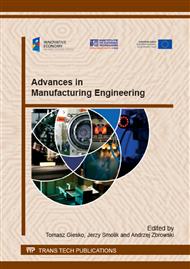p.221
p.231
p.238
p.246
p.255
p.264
p.272
p.283
p.291
Monitoring the FSW Processes Using a Multispectral Vision Method
Abstract:
The FSW method is a modern and still not very common method for joining materials by mixing them after plasticising with a special tool. The rotary motion of the tool and its pressure against the welded surface causes friction and, as an effect, local heating of the material that then causes plasticisation. Then the tool moves linearly along the trajectory of welding, while the stem causes the mixing of materials and tool’s shoulder concentrates and presses the material in the produced weld. An important feature of the process is that the material does not pass to the liquid phase and remain in the solid phase. This method allows the combination of non-welding and difficult to weld materials, including combining different materials (dissimilar). The FSW method is a new method and there are no tools to assess the quality of the process, especially on-line, that is in the making of the weld. Currently, the research methods used include point temperature measurement and measurement of forces on the tool performed during welding, and metallographic methods that are destructive can be used after the weld. This article presents the authors’ method for monitoring the Friction Stir Welding (FSW) processes with use of a multi-spectral vision method. The monitoring method uses the system built of two visual channels that work in different light bands; hence, the name of the method is multi-spectral. The main component of the system is an infrared camera that is used for the observation of the temperature distribution on the surface of the welded materials. The second visual channel uses the line-scan visual band camera for recording the image of the surface of the weld. Such observation allows the detection of weld defects and non-compliances, which include excessive burrs, discontinuities, uneven edge of the weld, as well as the subsurface faults such as cavities and sub-surface discontinuities. In addition, the temperature of the process is monitored to prevent under-and over-heating, which may result in a weak joint or cracks in the material. The presented method is applied for monitoring the FSW process and presents a worldwide novelty.
Info:
Periodical:
Pages:
255-263
Citation:
Online since:
November 2014
Authors:
Price:
Сopyright:
© 2015 Trans Tech Publications Ltd. All Rights Reserved
Share:
Citation:


